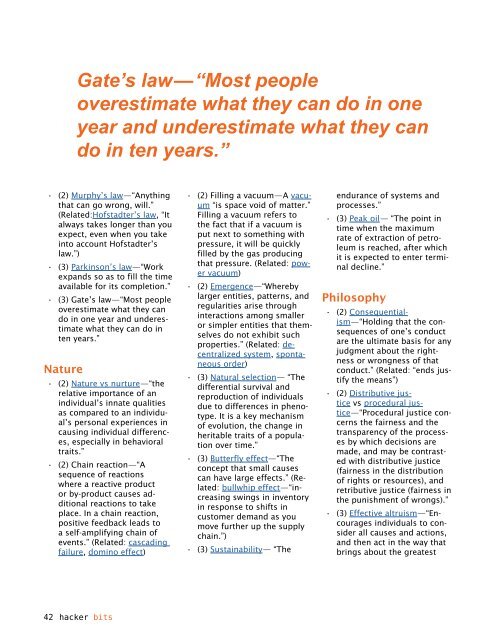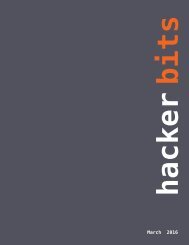Hacker Bits, August 2016
HACKER BITS is the monthly magazine that gives you the hottest technology stories crowdsourced by the readers of Hacker News. We select from the top voted stories and publish them in an easy-to-read magazine format. Get HACKER BITS delivered to your inbox every month! For more, visit https://hackerbits.com/2016-08.
HACKER BITS is the monthly magazine that gives you the hottest technology stories crowdsourced by the readers of Hacker News. We select from the top voted stories and publish them in an easy-to-read magazine format.
Get HACKER BITS delivered to your inbox every month! For more, visit https://hackerbits.com/2016-08.
You also want an ePaper? Increase the reach of your titles
YUMPU automatically turns print PDFs into web optimized ePapers that Google loves.
Gate’s law — “Most people<br />
overestimate what they can do in one<br />
year and underestimate what they can<br />
do in ten years.”<br />
• (2) Murphy’s law — “Anything<br />
that can go wrong, will.”<br />
(Related:Hofstadter’s law, “It<br />
always takes longer than you<br />
expect, even when you take<br />
into account Hofstadter’s<br />
law.”)<br />
• (3) Parkinson’s law — “Work<br />
expands so as to fill the time<br />
available for its completion.”<br />
• (3) Gate’s law — “Most people<br />
overestimate what they can<br />
do in one year and underestimate<br />
what they can do in<br />
ten years.”<br />
Nature<br />
• (2) Nature vs nurture — “the<br />
relative importance of an<br />
individual’s innate qualities<br />
as compared to an individual’s<br />
personal experiences in<br />
causing individual differences,<br />
especially in behavioral<br />
traits.”<br />
• (2) Chain reaction — “A<br />
sequence of reactions<br />
where a reactive product<br />
or by-product causes additional<br />
reactions to take<br />
place. In a chain reaction,<br />
positive feedback leads to<br />
a self-amplifying chain of<br />
events.” (Related: cascading<br />
failure, domino effect)<br />
• (2) Filling a vacuum — A vacuum<br />
“is space void of matter.”<br />
Filling a vacuum refers to<br />
the fact that if a vacuum is<br />
put next to something with<br />
pressure, it will be quickly<br />
filled by the gas producing<br />
that pressure. (Related: power<br />
vacuum)<br />
• (2) Emergence — “Whereby<br />
larger entities, patterns, and<br />
regularities arise through<br />
interactions among smaller<br />
or simpler entities that themselves<br />
do not exhibit such<br />
properties.” (Related: decentralized<br />
system, spontaneous<br />
order)<br />
• (3) Natural selection — “The<br />
differential survival and<br />
reproduction of individuals<br />
due to differences in phenotype.<br />
It is a key mechanism<br />
of evolution, the change in<br />
heritable traits of a population<br />
over time.”<br />
• (3) Butterfly effect— “The<br />
concept that small causes<br />
can have large effects.” (Related:<br />
bullwhip effect — “increasing<br />
swings in inventory<br />
in response to shifts in<br />
customer demand as you<br />
move further up the supply<br />
chain.”)<br />
• (3) Sustainability — “The<br />
endurance of systems and<br />
processes.”<br />
• (3) Peak oil — “The point in<br />
time when the maximum<br />
rate of extraction of petroleum<br />
is reached, after which<br />
it is expected to enter terminal<br />
decline.”<br />
Philosophy<br />
• (2) Consequentialism<br />
— “Holding that the consequences<br />
of one’s conduct<br />
are the ultimate basis for any<br />
judgment about the rightness<br />
or wrongness of that<br />
conduct.” (Related: “ends justify<br />
the means”)<br />
• (2) Distributive justice<br />
vs procedural justice<br />
— “Procedural justice concerns<br />
the fairness and the<br />
transparency of the processes<br />
by which decisions are<br />
made, and may be contrasted<br />
with distributive justice<br />
(fairness in the distribution<br />
of rights or resources), and<br />
retributive justice (fairness in<br />
the punishment of wrongs).”<br />
• (3) Effective altruism — “Encourages<br />
individuals to consider<br />
all causes and actions,<br />
and then act in the way that<br />
brings about the greatest<br />
42 hacker bits















